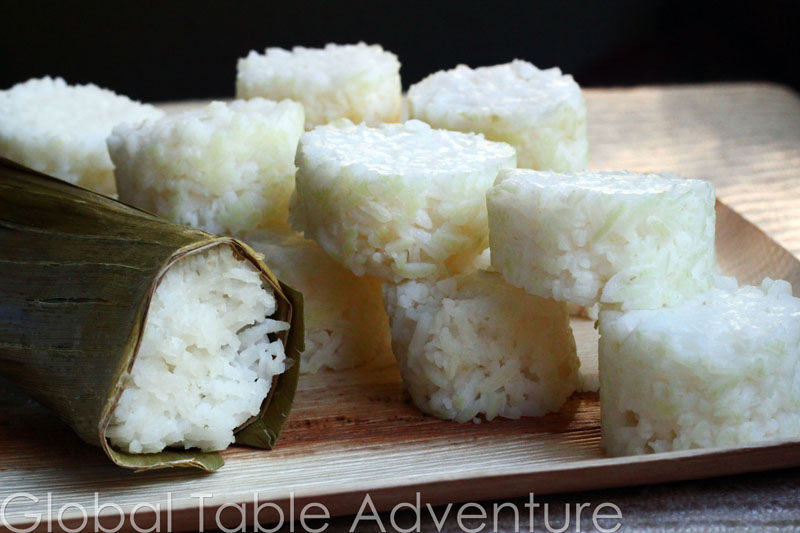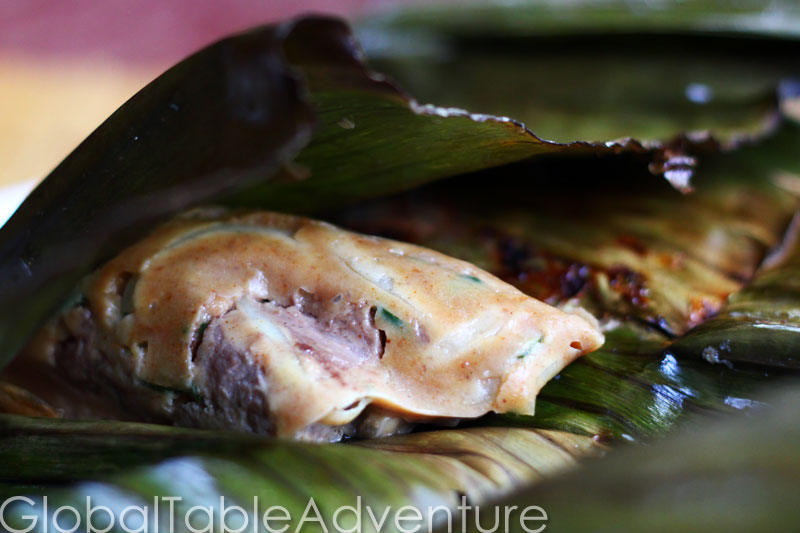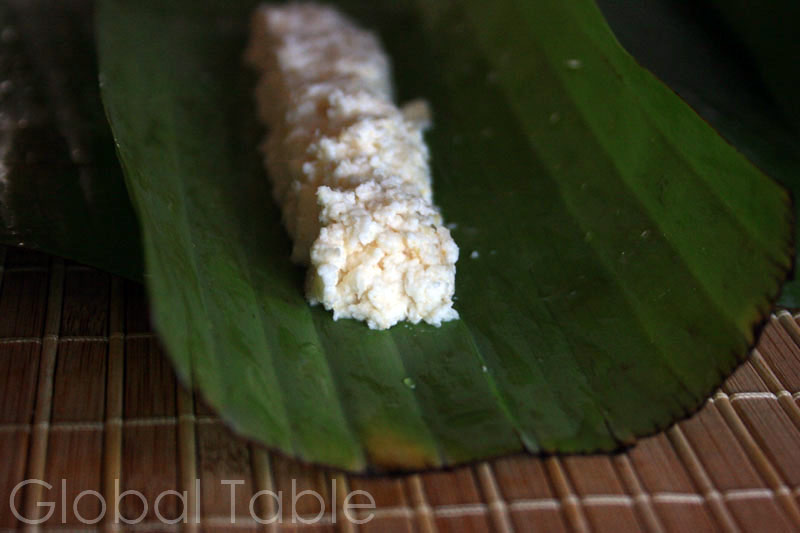
I don’t make a lot of really, really weird things on this blog. You won’t see deep-fried tarantulas or monkey brains. This is because I feel strongly that regular people (and by that I mean regular-really-special-all-kinds-of-wonderful people like you), living in average towns (that they love with all their heart, like you do) should be able to replicate this adventure without pulling their hair out by the roots. Simply put: the more people cooking the world, the better. And I’m here to make it as easy as possible. That being said, sometimes I run across really strange recipes made with really normal ingredients. These are like culinary goldmines for the stovetop traveler. Unique learning experiences that are not an impossible nightmare to cobble together. Fun, fun, fun. Take today’s recipe from Papua New Guinea: Saksak, a.k.a. Sago Dumplings. This slippery treat is made with nothing more than tapioca, bananas and sugar, wrapped up in a banana leaf “blanket” and swimming in a warm coconut sea. I found everything for the Saksak in our grocery store except for the banana leaves. …
Read More
Today we’re going to make a tower… a tower of glorious height. And this tall, sturdy tower is going to be made out of rice. Our inspiration? The Petronas towers of Malaysia. Aren’t they stunning? I adore the fact that the skyscrapers are connected by a tiny walkway that seems to be a million, zillion miles up in the sky. But that’s a story for another day. The fact is, I am simply thrilled to make rice towers from Malaysia. You see, I’m falling more and more in love with glutinous rice which is the secret to building our edible tower. I first made glutinous rice for Laos and, yikes, was I ever scared of messing it up. After that Adventure, however, I learned that glutinous rice is much more forgiving than traditional long-grain rice. It’s very hard to screw up. Which means, of course, that I’ll be making it more and more. And add coconut milk into the mix? Let’s just call this recipe love at first bite. NOTE: For this recipe, you can …
Read More
Serves 4 Steaming fish in banana leaves – extremely common in Africa – results in a light, healthy dish. Liboke is a congolese word (in the Lingala dialect) for packets of food cooked in banana leaves. Ingredients: 4 fish fillets (I used tilapia, you can use any white fish you like) 4 banana leaves (or sheets of aluminum foil) 1/2 onion, thinly sliced 1-2 tomatoes, thinly sliced lemon juice, to taste salt cayenne pepper Method: First, prepare the banana leaves. Trim off the tough side of the leaf. Then run the leaf quickly over a flame to soften it and make it more pliable. When it changes from dull to shiny, it is soft enough. Next, assemble the liboke. First the onions. Then, a few tomato slices. Jewl red and just as juicy. A pristine fillet of fish. No square, pressed fish here! Sprinkle with a bit of cayenne, if you dare! Or just a bit of lemon juice. Once you have everything in there, fold up the leaf like a burrito. Top down. Then, …
Read More
Serves 4 This traditional African dish combines peanut butter with goat, two of the most common ingredients in many parts of the continent, especially west and central Africa. Hot peppers and cayenne add kick. Ingredients: 1 lb goat meat, cubed 1/2 onion, sliced thinly 1 poblano pepper, sliced thinly 4 12″x12″ banana leaves (or sheets of aluminum foil) For the Sauce: 3/4 cup peanut butter 1 Tbsp bouillon 1/2 tsp cayenne water, as needed (I used 5 Tbsp) Method: Cube up some goat meat. The butcher cut me two pieces from the leg, with little bone. Next, mix up the ingredients for the sauce. First up – peanut butter. I open the jar, and my husband comes running. He loves the stuff. Some bouillon powder. Cayenne, for heat. Feel free to omit this or use less… but I hope you don’t. Finally, add water and mix all the ingredients together until a smooth sauce forms. I used about 5 tablespoons. Next, add in the meat. And onions. Make sure you slice them as thinly as …
Read More

The people of Brunei are brilliant. I’ve got proof – the lontong. This compact, slightly perfumed packet of white rice, stuffed inside a banana leaf, is portable, sliceable, flavorful, and affordable. Oh, and cutting the rice logs up into neat coins makes for easy portion control. Well. Ok. I’ll be honest. The coins just make it easier to pop a hundred million of them into my mouth. Yum. Lontong represents everything I love about food around the world. While we share similar staples – rice, potato, pasta, beans – it is the seasoning and the preparation which gives each country a unique spin. In the case of lontong, banana leaves infuse long grain rice with an earthy, grassy flavor. The result is mild “other-worldliness” – and insane, instantaneous addiction. I totally get why lontong is adored throughout Indonesia. Kids will love the novelty of this savory treat with curry and soups. Serve at room temperature or chilled. Ingredients: 2 cups white long grain rice 4 cups water (or 2 cups water and 2 cups …
Read More
Serves 8 What is a Bâton de Manioc? The pounded flesh of the yucca root, wrapped in banana leaves and steamed for several hours. These dense yuca sticks are great cut up and eaten with stew. They take on the flavor of the banana leaves (which taste like steamed artichoke). Note: Do NOT shred the tough fibers in the center of the cassava, as these are unfit to eat and may contain traces of cyanide (just like apple seeds). Ingredients: 2 lbs cassava tubers banana leaves or aluminum foil Method: 1. Peel tubers. 2. (This step is optional in the US) Soak the cassava tubers in a bucket of water for about 3 days. Rinse off. 3. Using a grater, shred the tubers into a large bowl. Again, be careful NOT to shred the tough fibers in the center, as these are unfit to eat. Then, using a pastry cutter (or potato masher), pound into a paste. NOTE: If you have a large enough mortar and pestle, you can use this as well. 4. Place about 1/4 cup of the paste …
Read More







